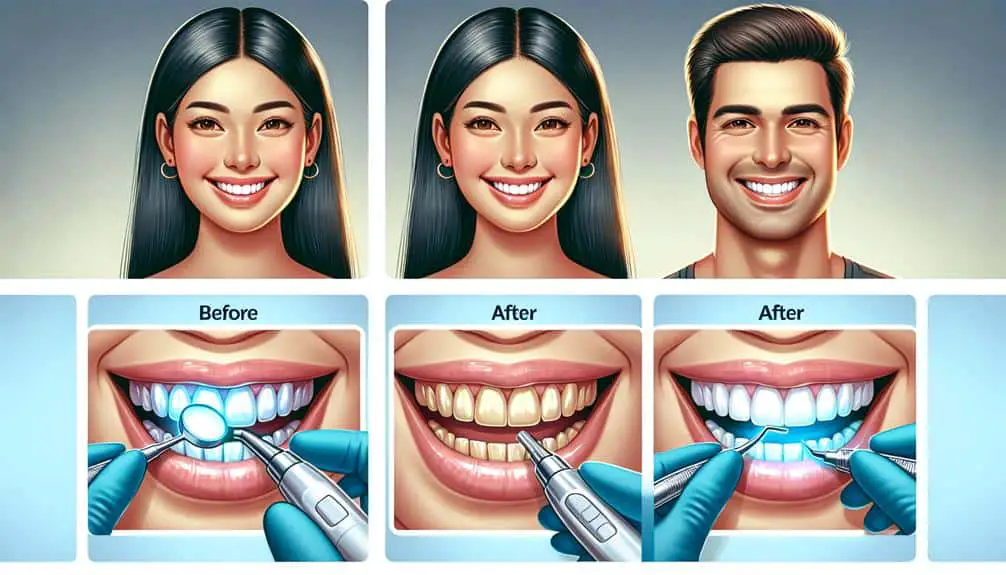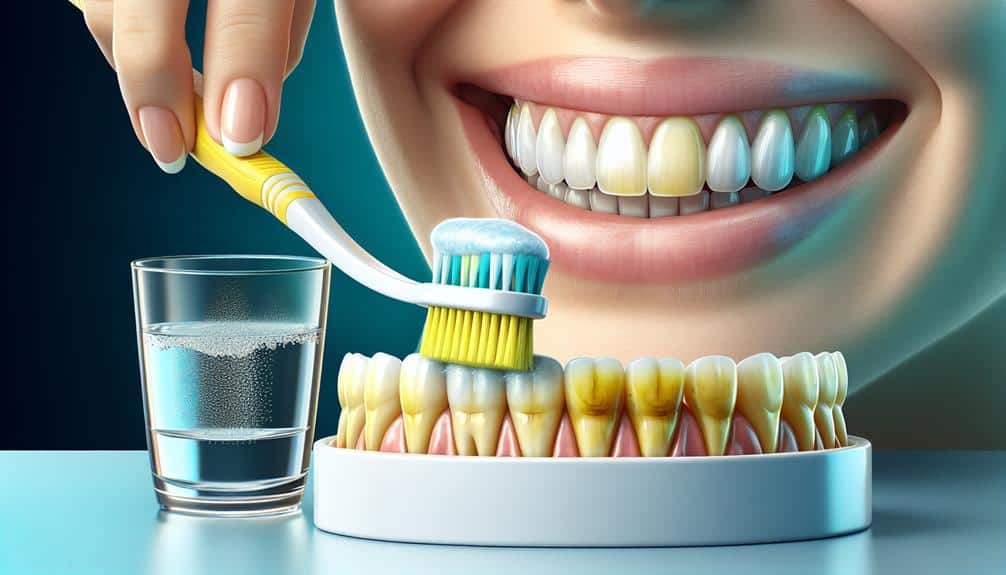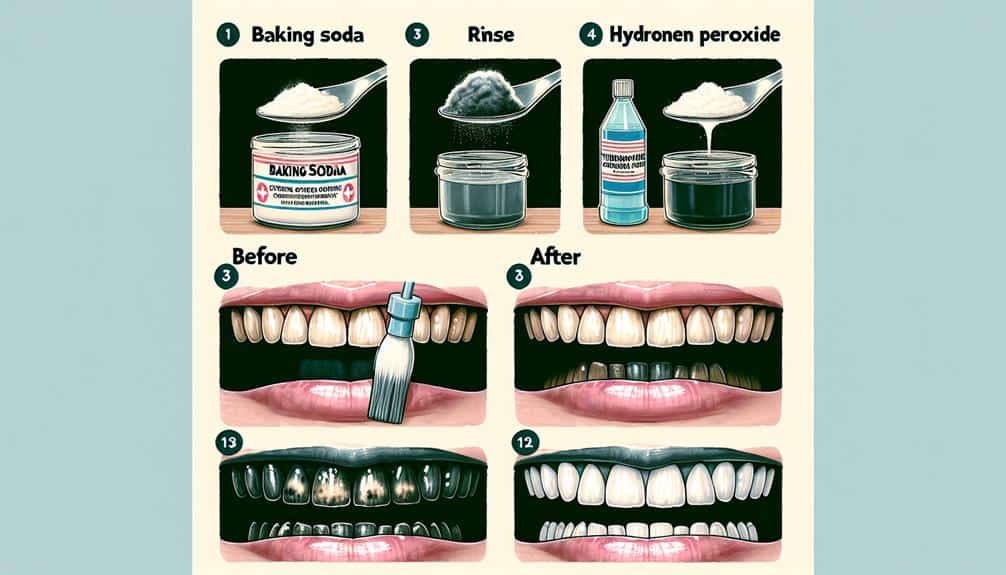For tetracycline stains, consider traditional methods like bleaching and professional cleaning. Severe cases may need veneers or crowns. Prioritize oral care before whitening. Specialized dental treatments offer high-concentration agents. Consult a dentist for tailored solutions. Try baking soda or hydrogen peroxide for natural remedies. Maintain whiteness with good oral hygiene habits. Brush and floss daily, limit staining foods for lasting results. Ready to brighten your smile?
Key Points
- Professional in-office bleaching with high-concentration agents.
- Explore natural remedies like baking soda and hydrogen peroxide.
- Consider oil pulling with coconut oil for bacteria removal.
- Use whitening mouthwash to maintain teeth whiteness.
- Establish consistent oral hygiene routine for lasting results.
Understanding Tetracycline Stains
If you have ever wondered why some teeth are discolored due to tetracycline stains, it's important to understand the underlying causes. Tetracycline discoloration occurs when the antibiotic tetracycline is taken during the period of tooth development, leading to a gray or brownish hue on the teeth. This happens because tetracycline becomes incorporated into the tooth structure, causing the discoloration.
When it comes to treating tetracycline stains, it's essential to take into account the severity of the discoloration. Mild cases may respond to traditional teeth whitening methods, such as bleaching or professional cleaning. However, more severe cases might require advanced treatments like veneers, bonding, or crowns to effectively mask the discoloration. Consulting with a dentist who specializes in cosmetic dentistry is vital to determine the most suitable treatment options for your specific situation.
Understanding the nature of tetracycline discoloration is the first step towards achieving a brighter, more confident smile.
Preparing for Tetracycline Teeth Whitening
To optimize the effectiveness of tetracycline teeth whitening procedures, it's important to adequately prepare by understanding the potential treatment options available for addressing the discoloration caused by tetracycline stains. A vital aspect of preparing for tetracycline teeth whitening is engaging in pre-whitening care. This involves maintaining good oral hygiene practices, such as regular brushing and flossing, to guarantee your teeth are clean and free of any surface stains before the whitening process begins.
When considering effective products for pre-whitening care, it's advisable to use a gentle whitening toothpaste that can help remove superficial stains without causing further damage to the enamel. Additionally, incorporating a mouthwash that targets bacteria and plaque can create a healthier environment for the whitening agents to work effectively.
Professional Whitening Treatments
Professional whitening treatments utilize advanced techniques to effectively remove deep-seated tetracycline stains and enhance the brightness of your teeth. In office procedures offer a range of bleaching options that can provide noticeable results in a shorter period compared to at-home treatments. Dentists often use high-concentration bleaching agents that aren't available for home use, ensuring a more significant reduction in tetracycline staining.
These in-office procedures typically involve applying a bleaching gel directly to the teeth and activating it with a special light or laser to accelerate the whitening process. The controlled environment of a dental office allows for careful monitoring and adjustment of the treatment to maximize results while minimizing the risk of sensitivity or damage to the gums.
Professional whitening treatments are tailored to your specific needs, taking into account the severity of tetracycline stains and your desired level of whitening. By consulting with a dental professional, you can explore the most suitable bleaching options to achieve a brighter, more confident smile.
Home Remedies for Tetracycline Stains
For addressing tetracycline stains at home, contemplate exploring natural remedies as a supplementary approach to professional whitening treatments. When facing tetracycline stains, natural alternatives can be effective in reducing discoloration.
DIY solutions using common household items like baking soda and hydrogen peroxide can help whiten teeth affected by tetracycline. Baking soda's mild abrasiveness can gently scrub away surface stains, while hydrogen peroxide acts as a bleaching agent to lighten the appearance of teeth. Mixing these two ingredients into a paste and brushing your teeth with it a few times a week may gradually diminish the appearance of tetracycline stains.
Another natural remedy to contemplate is oil pulling with coconut oil. This ancient practice involves swishing oil around in your mouth to remove bacteria and whiten teeth. The lauric acid found in coconut oil has antimicrobial properties that could contribute to improved oral health and potentially aid in reducing tetracycline stains.
Incorporating these natural alternatives into your oral care routine may provide a cost-effective and chemical-free way to address tetracycline stains at home.
Maintaining Whitened Tetracycline Teeth
Consider incorporating a consistent oral hygiene routine to preserve the whiteness achieved on tetracycline-stained teeth through natural remedies. Regular maintenance is key to sustaining the results of your whitening efforts.
Brush your teeth at least twice a day using a fluoride toothpaste to prevent the buildup of new stains. Floss daily to remove plaque and debris that can dull the brightness of your teeth. Additionally, consider using a whitening mouthwash to help maintain the whiteness of your teeth.
Lifestyle changes can also contribute to the longevity of your whitened tetracycline-stained teeth. Limit your consumption of staining substances like coffee, tea, and red wine. If you do indulge in these beverages, consider using a straw to minimize contact with your teeth. Quitting smoking can also prevent new stains from developing on your teeth.
Frequently Asked Questions
Can Tetracycline Teeth Whitening Treatments Be Safely Used on Children?
When considering tetracycline teeth whitening treatments for children, safety concerns must be prioritized. Due to potential risks and lack of data on effectiveness in younger individuals, age restrictions are typically in place. Seek alternatives for safer options.
Are There Any Specific Dietary Restrictions to Follow During Tetracycline Teeth Whitening?
Are dietary restrictions necessary during tetracycline teeth whitening? Yes, it's essential to avoid staining foods like coffee. Prioritize a balanced diet rich in fruits and vegetables for best results. Maintain good oral hygiene habits and lifestyle choices for lasting effects.
How Long Do Tetracycline Teeth Whitening Results Typically Last?
To maintain the longevity of your tetracycline teeth whitening results, consistent maintenance is key. Professional treatments offer lasting effects, typically lasting around 6 months. At-home whitening products can help prolong the results between professional sessions.
Are There Any Potential Side Effects or Risks Associated With Tetracycline Teeth Whitening Treatments?
When contemplating tetracycline teeth whitening treatments, it's crucial to be mindful of potential risks and side effects. Take proper precautions by consulting with a dentist. Safeguard children's safety by refraining from these treatments for minors.
Can Tetracycline Teeth Whitening Treatments Be Combined With Other Cosmetic Dental Procedures for Enhanced Results?
When looking to enhance results, combining procedures like tetracycline teeth whitening with other cosmetic dental treatments can be safe and effective. Consult with your dentist to create a personalized plan for achieving your desired smile.



